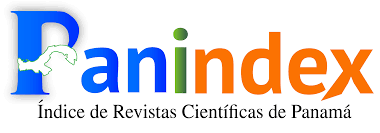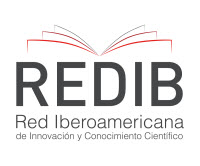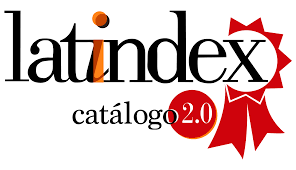
Esta obra está bajo una licencia internacional Creative Commons Atribución-NoComercial-CompartirIgual 4.0.
Esta obra está bajo licencia internacional https://creativecommons.org/licenses/by-nc-sa/4.0/deed.es
La revista (y sus contenidos) emplean las licencias Creative Commons, específicamente la del tipo CC BY NC SA 4.0, la cual establece que “el beneficiario de la licencia tiene el derecho de copiar, distribuir, exhibir y representar la obra y hacer obras derivadas siempre y cuando reconozca y cite la obra de la forma especificada por el autor o el licenciante”. La licencia del tipo CC BY NC SA 4.0 contempla tres categorías,
- Atribución.
- No Comercialización de la obra.
- Compartir igual
Los lectores son libres de:
- Compartir — copiar y redistribuir el material en cualquier medio o formato
- Adaptar — remezclar, transformar y construir a partir del materialLa licenciante no puede revocar estas libertades en tanto usted siga los términos de la licencia
- Siempre y cuando se respeten y contemplen la atribución de autoría y la no comercialización del material.
Resumen
Los escasos logros que se vienen observando en quienes participan en programas de inglés con la finalidad de aprender a comunicarse en dicha lengua, instan a revisar el rol de la forma en que se enseñan las habilidades lingüísticas del inglés, escuchar, hablar, leer y escribir (listening, speaking, reading, writing) en el logro de la competencia comunicativa a la que se aspira. A partir del análisis e interpretación de la información documental obtenida, este trabajo presenta un recuento de los principales conceptos relacionados con la enseñanza ya sea integrada o segregada de las habilidades lingüísticas y advierte sobre la necesidad de redirigir la manera en que se enseñan las habilidades lingüísticas, promoviendo una mayor integración de las mismas con el fin de lograr buenos niveles de competencia comunicativa.
Citas
Amin Mekheimer, M. and Shabieb Aldosari, H. (2013). Evaluating an Integrated EFL Teaching Methodology in Saudi Universities: A Longitudinal Study. Journal of Language Teaching and Research, Vol. 4, No. 6, pp. 1264-1276, November 2013.
Bachman, L.F., & Palmer, A.S. (1996). Language Testing in Practice: Designing and Developing Useful Language Tests. Oxford University Press.
Bachman, L.F. (1990). Fundamental Considerations in Language Testing. Oxford University Press.
Banegas, D. (2012). Integrating content and language in English language teaching in secondary education: models, benefits and challenges, Studies in Second Language Learning and Teaching 2/1: 111-136: Disponible en: https://repozytorium.amu.edu.pl/jspui/bitstream/10593/2907/1/SSLLT%202(1)%20111- 136%20Banegas.pdBrown, H. D. (2014). Principles of Language Learning and Teaching (6th Edition). Pearson.
Brown, H. D. (2008). Teaching by Principles: An Interactive Approach to Language Pedagogy (2nd Edition). Longman.
Brown, H. D. (2007). Principles of Language Learning and Teaching (5th Edition). Pearson.
Brown, S., and Larson-Hall, J. (2012). Second Language Acquisition Myths. Ann Arbor: University of Michigan Press.
Canale, M. (1983). From communicative competence to communicative language pedagogy. En Richards, J. C., & Schmidt, R. W. (Eds.), Language and Communication, 2-27. London: Longman.
Canale, M. (1984). A communicative approach to language proficiency assessment in a minority setting. En Rivera, C. (Ed.), Communicative competence approaches to language proficiency assessment: Research and application, 107-122. Clevedon: Multilingual Matters.
Canale, M., & Swain, M. (1980). Theoretical bases of communicative approaches to second language teaching and testing. Applied Linguistics, 1, 1-47.
Canale, M., & Swain, M. (1981). A Theoretical Framework for Communicative Competence. In Palmer, A., Groot, P., & Trosper, G. (Eds.), The construct validation of test of communicative competence, 31-36.
Celce-Murcia, M. (2014). An Overview of Language Teaching Methods and Approaches. En Celce-Murcia, M., Brinton D., and M. Snow. Teaching English as a Second or Foreign Language (4th Edition). Boston, MA: Heinle Cengage Learning.
Celce-Murcia, M and Olshtain, E. (2014). Teaching Language through Discourse. En Celce-Murcia, M., Brinton D., and M. Snow. Teaching English as a Second or Foreign Language (4th Edition). Boston, MA: Heinle Cengage Learning.
Celce-Murcia, M., Brinton D., and M. Snow. (2014). Teaching English as a Second or Foreign Language (4th Edition). Boston, MA: Heinle Cengage Learning.
Chamot, A. U. and O’Malley, M. J. (1994). The CALLA Handbook: How to implement the Cognitive Academic Language Learning Approach. Reading, MA: Addison Wesley.
Cummins, J. (2006). Language, Power, and Pedagogy: Bilingual Children in the Crossfire. Great Britain: Cromwell Press Ltd.
Cummins, J. (1984). Bilingualism and Special Education: Issues in Assessment and Pedagogy. San Francisco, CA: College-Hill Press.
Cushing, S. (2014). Considerations for Teaching Second Language Writing. En Celce-Murcia, M., D. Brinton, and M. Snow. Teaching English as a Second or Foreign Language (4th Edition). Boston, MA: Heinle Cengage Learning.
Diana, S. (2014). Communicative Language Teaching and Its Misconceptions about the Practice in English Language Teaching (ELT). Bahasa & Sastra, Vol. 14, N° 1, April 2014.
Duff, P.A. (2014). Communicative Language Teaching. En Celce-Murcia, M., D. Brinton, and M. Snow. Teaching English as a Second or Foreign Language (4th Edition). Boston, MA: Heinle Cengage Learning.
Fromkin, V., R. Rodman, and N. Hyams. (2014). An Introduction to Language (10th Edition). Boston, MA: Wadsworth Cengage Learning.
Garton, S., and Graves, K. (2014). International Perspectives on Materials in ELT. Palgrave Macmillan UK.
Harmer, J. (2015). The Practice of English Language Teaching. Pearson.
Harmer, J. (1999). The Practice of English Language Teaching. Longman.
Hinkel, E. (2014). Culture and Pragmatics in Language Teaching and Learning. En Celce-Murcia, M., Brinton D., and M. Snow. Teaching English as a Second or Foreign Language (4th Edition). Boston, MA: Heinle Cengage Learning.
Hinkel, E. (2010). Integrating the Four Skills: Current and Historical Perspectives. En The Oxford Handbook of Applied Linguistics (2 ed.). Oxford University Press.
Huang, D. (2016). A Study on the Application of Task-based Language Teaching Method in a Comprehensive English Class in China. Journal of Language Teaching and Research, Vol. 7.
Hymes, D. (1972). On communicative Competence. En J. Pride y J. Holmes (Eds.), Sociolinguistics. Harmondsworth, UK: Penguin Books.
Instituto Cervantes. «Marco Común Europeo de Referencia: Presentación». Centro Virtual Cervantes. Instituto Cervantes. Consultado el 15 de septiembre de 2017.
Jing, W. (2006). Integrating Skills for Teaching EFL-Activity Design for the Communicative Classroom. Sino-US English Teaching, Dec. Volume 3, No.12.
Kumaravadivelu, B. (2006). Understanding Language Teaching. From Method to Postmethod. Mahwah, New Jersey: Lawrence Erlbaum Associates, Publishers.
Lyutaya, Tatiana. (2011). Reading Logs: Integrating Extensive Reading with Writing Tasks. English Teaching Forum, N°1.
Marco Común Europeo de Referencia para las Lenguas: Aprendizaje, Enseñanza, Evaluación. (2002). Ministerio de Educación, Cultura y Deporte, Subdirección General de Cooperación Internacional, para la edición impresa en español. Coeditan: Secretaría General Técnica del MECD-Subdirección General de Información y Publicaciones, y Grupo ANAYA, S.A. Paseo del Prado, Madrid
Mekheimer, M. (2011). ‘Effectiveness of an Integrated, Holistic Pedagogy of EFL Skills in College Students’. Journal of Education. (25), 100. Kuwait.
Mohan, B. (1986). Language and content. Reading. MA: Addison Wesley.
Nunan, D. (2010). Task Based Language Teaching. Online Publication. Oxford University Press.
Oxford, R. (2001). ‘Integrated Skills in the ESL/EFL Classroom’. ERIC Digest. ED456670.
Richards, J.C. (2006). Communicative Language Teaching Today. Cambridge: Cambridge University Press.
Richards, J.C. & Rodgers, T.S. (2014). Approaches and Methods in Language Teaching. Cambridge: Cambridge University Press.
Richards, J.C. & Schmidt, R. (2002). Longman Dictionary of Language Teaching and Applied Linguistics (3ra Ed.). Harlow: Pearson Education Limited.
Richards, J.C., Platt, J & Weber, H. (1985). Longman Dictionary of Language Teaching and Applied Linguistics. Pearson Education Limited.
Savignon, S. J. (1983). Communicative Competence: Theory and Classroom Practice. Texts and Contexts in Second Language Learning. Reading, Massachusetts: Addison-Wesley Publishing Company.
Shigeru, S. (2013). How CLIL can impact on EFL teachers’ mindsets about teaching and learning: an exploratory study on teacher recognition, International CLIL Research Journal 2/1: 55-66. Disponible en http://www.icrj.eu/21/article 5.html
Tajzad, M. & Namaghi, S. A. O. (2014). Exploring EFL Learners’ Perceptions of Integrated Skills Approach: A Grounded Theory. English Language Teaching, 7(11), 92-98. Recuperado de http://files.eric.ed.gov/fulltext/EJ 1075939.pdf.
Wannagat, U. (2007). Learning through L2--Content and Language Integrated Learning (CLIL) and English as Medium of Instruction (EMI), International Journal of Bilingual Education and Bilingualism 10/5: 663-682.
Widdowson, H.G. (1978). Teaching Language as Communication. Oxford: Oxford University Press.

















